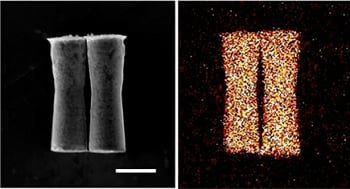 |
| Scanning electron microscopy image (left) of the polymer-zinc micromotors and the corresponding energy-dispersive X-ray spectroscopy data of elemental zinc in the micromotors--Courtesy of UCSD |
Tiny polymer tubes coated with zinc may one day be able to treat stomach conditions such as ulcers by acting as "micromotors" carrying drugs to the stomach lining. Animal studies at the University of California, San Diego, demonstrated in vivo that the synthetic motors enhanced the efficiency of drug delivery to the stomach.
The tiny polymer-zinc tubes feature acid-powered propulsion, a high loading capacity, the autonomous release of payloads and nontoxic self-destruction, according to an article published in the journal ACS Nano.
Previously, similar micromotors have been tested in vitro, but this experiment marks the first time the machines worked in a living organism.
In mice, the scientists administered the micromotors directly to the stomach lining using a gastric tube. Once the zinc comes in contact with the harsh acidic environment of the stomach, the metal reacts to release hydrogen bubbles, propelling it forward, leading to greater tissue penetration and retention compared with passive methods. What's more, the zinc coating eventually dissolves in the acid, leaving no harmful pieces behind.
As a model cargo in place of a drug, the team used gold nanoparticles, which could be used down the road as imaging agents or drug carriers themselves. The mice treated with the new micromotors retained about three times as much of the gold nanoparticle cargo as did those treated orally, which allows only passive retention.
- here's the ACS Nano article